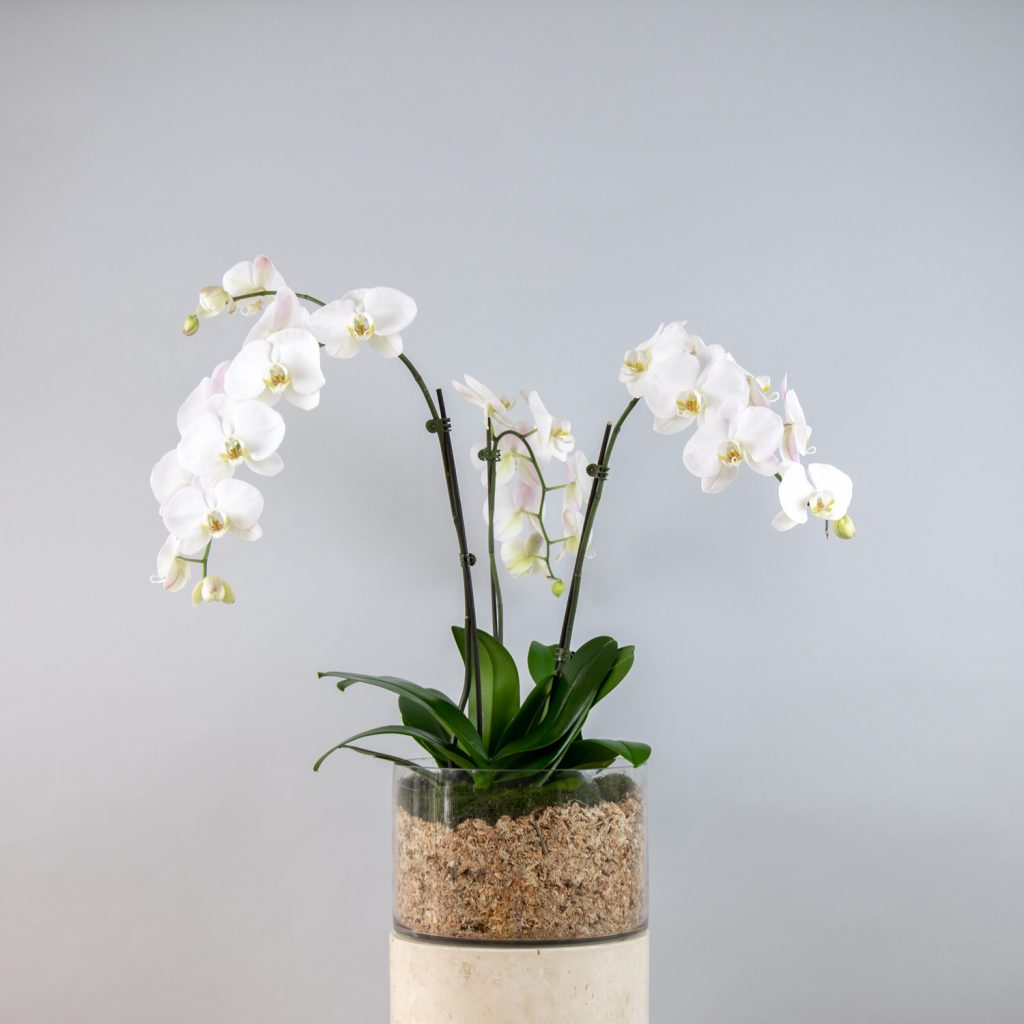There’s a reason orchids sit in hotel lobbies, wedding bouquets and the corner of stylish kitchens: they read simultaneously as delicate and indestructible, rare and totally at home on a sill. Their sculptural blooms, endless variety and surprising longevity make them an enduring favourite — whether you’re buying a gift or coaxing a bloom from your own windowsill.
Below we unpack why orchids have such wide appeal, what they symbolise, and practical care tips so your orchid thrives.
Why people fall for orchids
- Sculptural beauty. Orchid flowers are architectural: precise petals, elegant lips and a symmetry that feels both exotic and modern.
- Longevity. A well-cared-for flowering spike can last weeks to months — unlike many cut blooms, orchids reward patience.
- Perceived luxury. Orchids carry a sense of occasion without being overbearing. They feel considered rather than showy.
- Variety for every space. From compact Phalaenopsis to dramatic Cattleya and architectural Cymbidiums, there’s an orchid to suit a sunny windowsill or cool glasshouse.
- Low-frequency care (when you know how). Many common orchids tolerate infrequent watering and stable indoor conditions — attractive to busy people who still want living beauty.
What orchids traditionally symbolise
- Beauty and refinement. Across cultures, orchids signify cultivated taste and aesthetic appreciation.
- Love and luxury. In the West, they often read as a sophisticated token of affection.
- Fertility and virility. Historically (and etymologically — orchis is Greek for testicle), orchids have been linked to fertility.
- Strength and rare beauty. In Asia, orchids are associated with honour, nobility and resilience.
Meanings shift by culture and context, but the common thread is that orchids carry weight: they’re not casual flowers. Giving one suggests thought, taste and intention.
The most common house orchids (quick guide)
- Phalaenopsis (Moth Orchid): Best for beginners — forgiving, long-blooming, widely available.
- Cattleya: Bold, often perfumed, favoured for weddings and special bouquets.
- Dendrobium: Elegant canes with many flowers; varied care needs depending on species.
- Oncidium: “Dancing lady” orchids with sprays of smaller flowers; airier look.
- Paphiopedilum (Lady’s Slipper): Distinctive pouch-shaped lip and typically enjoys lower light.
Essential orchid care (simple, practical)
- Light: Bright, indirect light is ideal. East or west-facing windows with a curtain work well. Avoid hot midday sun that scorches leaves.
- Water: Most household orchids prefer a soak-and-dry routine. Water thoroughly, then let the potting medium dry slightly before the next drink. A guide: every 7–14 days depending on potting mix, pot size and indoor climate.
- Potting mix: Use chunky, well-draining media (bark, perlite, charcoal). Orchids dislike sitting in soggy compost.
- Humidity: Aim for moderate humidity (40–70%). Grouping plants, misting lightly, or using a pebble tray helps in dry homes.
- Temperature: Most common types prefer daytime temperatures 18–28°C and slightly cooler nights — a modest day–night drop often encourages flowering.
- Feeding: Use a balanced orchid fertiliser at half strength every 1–2 weeks during the growth period; reduce in winter. “Weakly, weekly” is a good mantra.
- Repotting: Re-pot every 1–3 years or when the potting bark breaks down. Do this after flowering and when new roots appear.
- Airflow: Gentle airflow prevents rot and disease. Avoid stagnant corners.
Troubleshooting — common problems and fixes
- Yellowing leaves: Often overwatering or poor drainage. Check roots — healthy roots are firm and green/white.
- Dropping buds: Shock from temperature changes, drafts, or low humidity. Stabilise conditions and avoid moving the plant during budding.
- Black soft spots/rot: Usually from prolonged wetness — trim to healthy tissue, improve drainage and airflow.
- No flowers on spikes: Likely insufficient light or too little cold-night stimulus (some types need a temperature dip). Try brighter indirect light and a slight night-time cool-down.
Propagation and longevity
- Keikis: Phalaenopsis sometimes produce “baby” plants (keikis) on the spike — these can be potted once roots form.
- Division: Sympodial orchids (Cymbidium, some Dendrobiums) are divided when they outgrow their pot.
With care, orchids can bloom year after year and live for many seasons — they become long-term companions.
Gifting, styling and responsible choices
- As a gift: Present an orchid in a clean, attractive pot with a care card. It’s a present that keeps giving.
- Styling: A single stem in a tall glass cylinder reads contemporary; a grouped display of mixed orchids feels luxurious.
- Sourcing: Choose ethically sourced orchids and, where possible, locally grown stock. This supports growers and reduces the environmental footprint.
Final thoughts
Orchids are popular because they marry beauty with endurance and a quiet theatricality. They ask for attention but not domination; they reward the small, steady acts of care with long-lasting blooms. If you want a plant that looks considered in any room, an orchid is a deceptively easy way to lift a space.
If you’d like help choosing the right orchid for your home or a thoughtful gift, B&M Florist stocks seasonal varieties and offers tailored care advice. Visit us in store or browse our curated collection online — we’ll help you find the right plant to suit your light, lifestyle and aesthetic.



